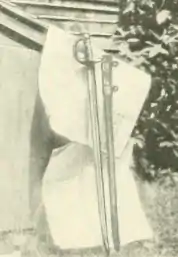Johnson Harmon
Colonel Johnson Harmon (or Harman; c. 1675 – 1751) was an army officer in colonial America. He led the expedition during Father Rale's War that killed Father Sébastien Rale in the Battle of Norridgewock. Harmon was heralded as a hero upon his return to Boston. New England Officer and historian Samuel Penahallow proclaimed the attack was "the greatest victory we have obtained in the three or four last wars."[2]

Career
Harmon was from York and was a teenager during the Raid on York (1692) during King Williams War.[3] During Queen Anne's War, in 1707 he was present, with his younger brother John, at Winter Harbour (Biddeford, Maine) he helped repulse the attack of natives in 50 canoes.[4][3] In this battle Benjamin Donnell was killed by Indians.[5] On 10 October 1710 Bomazeen with 60–70 Indians attacked the village of Winter Harbour, killing 3-4 and taking many more prisoner, including Harmon.[6] (Harmon was part of the expedition that killed Bomazeen, upon their return from the Battle of Norridgewock.[4]) He was released from captivity at Chambly, Quebec on 22 May 1711 in exchange for Beauvenire de Vercheres who was taken in the Raid on Haverhill (1708).[7][8][9]
In 1716, Harmon was considered for the position of messenger for the Indians.[9]
A year prior to the Battle of Norridgewolk, the Abenaki Indians made a failed attempt to assassinate Harmon.[10]
Harmon was the brother-in-law of the second-in-command of the expedition to Norridgewock, Col. Jeremiah Moulton. He was the father-in-law of the soldier that killed Rale, Richard Jacques.
Harmon was representative to the Massachusetts General Court (1727).[4][11]
At age 70, Harmon applied to fight in the Siege of Louisbourg (1745). While Harmon did not fight in the Siege, Moulton and Jacques did.
References
- Desmarais, Barbara (September 7, 2017). "Winners and Losers: Part 2-The Rest of the Story".
- French & Indian Wars in Maine By Michael Dekker, p. 70
- "Background on Historical Snowshoe Companies | Harmon's Snowshoemen". www.snowshoemen.com.
- Coleman, Emma Lewis (January 29, 2008). New England Captives Carried to Canada Between 1677 and 1760 During the French and Indian Wars: Volume 1 ONLY. Heritage Books. ISBN 9780788445897 – via Google Books.
- "Henry DONNELL of York, Maine". freepages.rootsweb.com.
- Hutchinson, Thomas (January 29, 1828). "The history of the province of Massachusets-Bay". Boston ; New-England : Printed by Thomas & John Fleet at the Heart and crown in Cornhill – via Internet Archive.
- Baker, C. Alice (Charlotte Alice) (January 29, 1897). "True stories of New England captives carried to Canada during the old French and Indian wars [microform]". Cambridge [Mass. : s.n.] – via Internet Archive.
- Coleman, Emma Lewis (January 29, 2008). New England Captives Carried to Canada Between 1677 and 1760 During the French and Indian Wars: Volume 1 ONLY. Heritage Books. ISBN 9780788445897 – via Google Books.
- "Acts and resolves passed by the General Court". Boston : Secretary of the Commonwealth. January 29, 1663 – via Internet Archive.
- Sketches of the Ecclesiastical History of the State of Maine: From the ..., p. 79
- Harmon Gaenology, p. 140